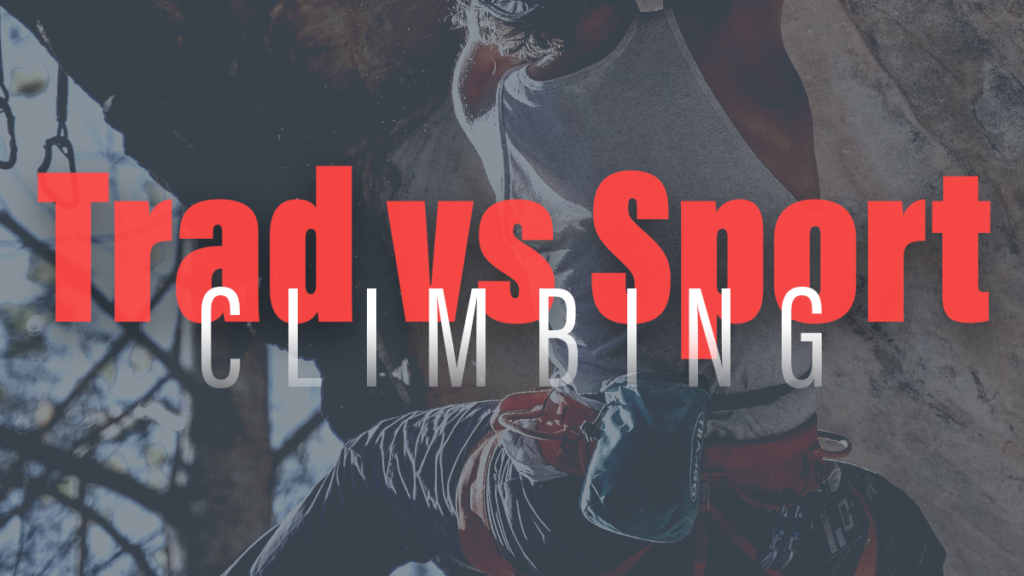Have you ever wondered what the differences between trad and sport climbing are? From afar, they look the same, don’t they? Somebody climbs up a wall with a rope attached to them. Is there any more to it?
Trad is short for Traditional, which is how people climbed up over the last few decades. Back before sport climbing garnered popularity in the 80s and 90s, trad climbing was just called, “climbing”. These two styles, although similar in appearance, are vastly different.
Trad Climbing
- Trad – Traditional
- Pro – Protection
- Passive Pro – Protection with no moving parts
- Active Pro – Protection with moving parts
Trad climbing is the art of climbing a rock face while placing pro into weaknesses, (cracks or seams), to reach the top. There are a few types of protection trad climbers use, ranging in size from pencil thin to as big as a soccer ball.
Active Pro – Spring-loaded camming devices that contract to fit into cracks and expand to fill the void.
Passive Pro – Simple, tapered metal chunks wedged into cracks.
This style of climbing requires a lot of gear. A climber needs to carry all the pro they will use, the slings and carabiners to attach themselves to said pro, and oftentimes, anchor building gear when they reach the top.
Once a climber places pro into the wall, they then need to attach a sling to this with a carabiner and then clip themselves in with the other carabiner attached. Trad climbing requires knowledge of gear and how to place it, assessment of the dangers of a fall, the quality of the rock where the pro is used, and where a pro can be inserted next up the route.
Sport Climbing
Sport climbing follows a route where metal bolts have been drilled or glued into the wall by a previous developer, ending at an anchor with more bolts to clip the rope through. Gear used for sport climbing is known as:
Quickdraw – Two carabiners attached by semi-rigid sewn webbing, known as the “dogbone”.
As a climber progresses up a route, they clip one side of the quickdraw to the bolt in the wall and the rope into the other. There is no need to carry multiple sizes of quickdraws unless a climber wants to protect a fall better, and the only difference here is the length of the quickdraw. Once a sport climber reaches the end of a route, they clip in more quickdraws to the anchors and clip their rope through.
Trad v Sport
Trad climbing requires more gear and route finding than sport climbing. This style will follow cracks and seams up a rock face while sport climbing will follow pre-drilled bolts, making it easier to know where you’re going.
Sport climbing is sometimes seen as the simple version of route climbing. Instead of carrying plenty of gear you may or may not use, the climber takes the exact amount of gear, (usually with an extra quickdraw or two just in case).
Where to Climb
You’ll find many crags have a few trad climbs while primarily consisting of sport climbs. Places like Indian Creek in Utah or The Gunks in New York are considered trad crags because of their lack of bolted routes, while Smith Rock in Oregon or The Red River Gorge in Kentucky are jammed packed with sport climbs.
Sport climbing is popular in climbing gyms because quickdraws can be fixed to the walls while trad climbing is done outside due to a number of additional risks that climbers take on when trad climbing.
If venturing off into the mountains to climb big walls, (routes that take multiple days to accomplish) or climb in more remote areas, you’ll typically find trad routes. While longer bolted climbs exist, sport climbing is usually done in a single pitch where the climber has lowered back to the ground after.
How To Get Started
Learning how to place gear or clean a route are aspects of climbing you should practice before you try it on a route. Climbing something without the necessary knowledge can result in injury or even death. Before you decide to try either of these disciplines of climbing, reach out to your local climbing gym or guiding service to see if they offer classes.

